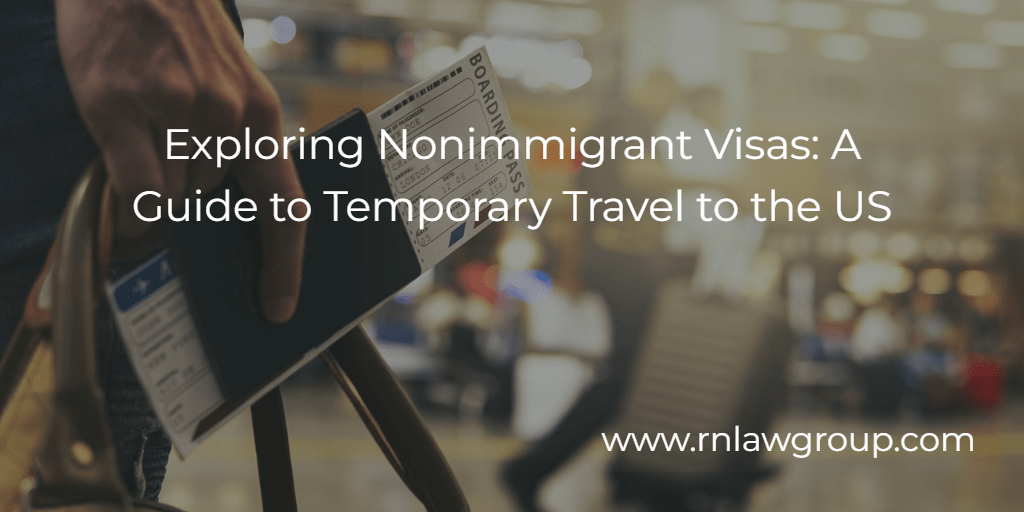
Exploring Nonimmigrant Visas: A Guide to Temporary Travel to the US
When it comes to visiting the United States for a temporary period of time, there are a variety of nonimmigrant visas available depending on the purpose of the visit. These visas allow foreign nationals to enter the country for a specific reason, such as work, study, or tourism. In this article, we will explore the different types of nonimmigrant visas available, the requirements for each visa, and provide examples of who may be eligible for each type.
- B-1/B-2 Visitor Visa: This visa is for individuals who want to visit the United States for a short period of time for business (B-1) or pleasure/tourism (B-2). Examples of eligible individuals may include tourists, individuals visiting friends or family, or those attending a business conference. Requirements for this visa include demonstrating the intent to return home after the visit, having sufficient funds to cover the expenses of the trip, and showing ties to the home country.
- F-1 Student Visa: This visa is for individuals who want to pursue academic studies or language training programs in the United States. Examples of eligible individuals may include undergraduate or graduate students, research scholars, or individuals pursuing vocational or technical training. Requirements for this visa include being accepted by a Student and Exchange Visitor Program-approved school, having sufficient funds to cover the expenses of the program, and showing ties to the home country.
- J-1 Exchange Visitor Visa: This visa is for individuals who want to participate in a cultural exchange program or educational exchange program in the United States. Examples of eligible individuals may include au pairs, research scholars, or individuals participating in a training program. Requirements for this visa include being sponsored by a designated exchange program sponsor, having sufficient funds to cover the expenses of the program, and showing ties to the home country.
- H-1B Specialty Occupation Visa: This visa is for individuals who want to work in a specialty occupation in the United States, such as engineering, science, or information technology. Examples of eligible individuals may include engineers, scientists, or computer programmers. Requirements for this visa include having a job offer from a U.S. employer, possessing the required education and experience for the job, and meeting the prevailing wage requirement.
- L-1 Intracompany Transferee Visa: This visa is for individuals who work for a multinational company and want to transfer to a U.S. branch or affiliate for a temporary period of time. Examples of eligible individuals may include executives, managers, or employees with specialized knowledge. Requirements for this visa include working for a multinational company, having been employed with the company for at least one year, and having a job offer from a U.S. employer.
- E-2 Treaty Investor Visa: This visa is for individuals who want to invest a substantial amount of money in a U.S. business and manage that business. Examples of eligible individuals may include entrepreneurs, investors, or business owners. Requirements for this visa include being a citizen of a country that has a treaty of commerce and navigation with the United States, investing a substantial amount of money in a U.S. business, and actively managing that business.
- E-1 Treaty Trader Visa This visa is designed for individuals who are engaged in substantial trade between their home country and the United States. This visa allows foreign nationals to come to the United States for the purpose of conducting trade activities, such as buying and selling goods or services. To be eligible for the E-1 Treaty Trader Visa, individuals must be a citizen of a country that has a treaty of commerce and navigation with the United States. They must also be actively engaged in substantial trade between the United States and their home country, either as an individual or as a representative of a qualifying organization.
- H-3 Visa: This visa is a nonimmigrant visa that allows individuals to come to the United States for the purpose of receiving training in a specific field. This visa is typically used by foreign nationals who wish to acquire new skills or knowledge that is not readily available in their home country. Eligible individuals must be invited by a U.S. employer or organization to participate in a training program. The training must be related to the individual’s field of work, and it must not be available in their home country. Additionally, the training program must be designed to benefit the individual’s future employment prospects outside of the United States.
There are a variety of nonimmigrant visas available depending on the purpose of the visit to the United States. Each visa has specific requirements and eligibility criteria that must be met, and it is important to carefully consider which visa is the most appropriate for the specific situation. By understanding the different types of nonimmigrant visas available, individuals can make informed decisions about which visa to apply for and how to maximize their chances of being approved. It is important to note that the application process for nonimmigrant visas can be lengthy and complex, so it is advisable to start the process well in advance of the intended travel date.
Additionally, it is important for individuals to carefully consider the purpose of their visit and ensure that they are applying for the appropriate visa. Applying for the wrong visa could result in a denial of the application or complications upon entry to the United States. It is also important to note that nonimmigrant visas are temporary and do not provide a path to permanent residency or citizenship.
Finally, it is important for individuals to be aware of any changes or updates to nonimmigrant visa policies and regulations. Visa policies can change frequently, and it is important to stay up to date on any changes that may affect the application process or eligibility criteria.
In conclusion, the different types of nonimmigrant visas available provide opportunities for individuals to visit the United States for a variety of purposes, including work, study, and tourism. Each visa has specific requirements and eligibility criteria that must be met, and it is important for individuals to carefully consider their situation and choose the appropriate visa. By doing so, they can maximize their chances of being approved and ensure a smooth and successful visit to the United States.
By: Felipe Jimenez
Felipe Jimenez is an Associate Attorney at Reddy Neumann Brown PC He works in the H-1B Department where he assists clients through all phases of the non-immigrant visa process.
Reddy Neumann Brown PC has been serving the business community for over 20 years and is Houston’s largest immigration law firm focused solely on US. Employment-based immigration. We work with both employers and their employees, helping them navigate the immigration process quickly and cost-effectively.

